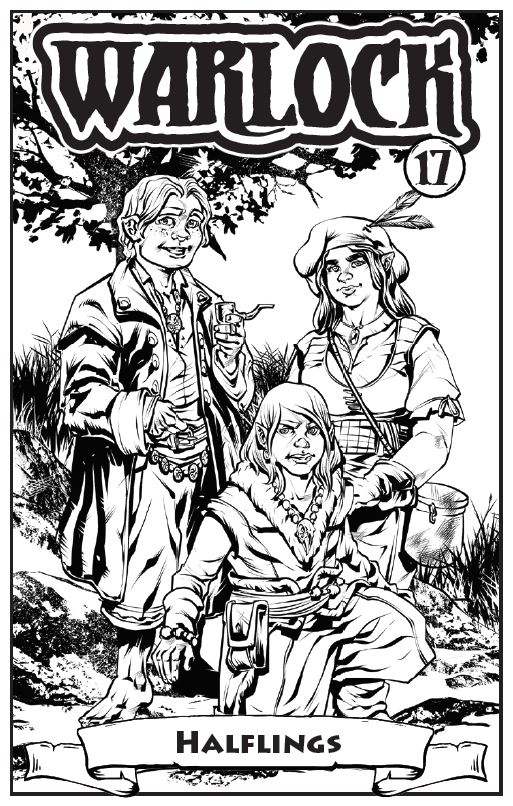No creature epitomizes the art of graceful service like the courtfolk, an accomplishment these halflings take with great (but quiet) pride. Courtfolk are defined by their dedication and deference to the great elven courts of old, but their identities are in flux in the wake of the Great Retreat. Now their oaths are sworn to the variable moods and personalities of scattered elfmarked lords, to the humans in large cities who see halflings as a simple labor force, and to rare elves who are not quite what they once were. Centuries of elven absence have been difficult on the courtfolk, but they, like all halflings, have proven capable of adapting to a world that no longer needs them as they were.
Fey-Touched Finery
Courtfolk are as small in size and stature as any halfling. Their long proximity to elves and the Elflands shows in their complexion, usually pale and freckled with light-colored eyes and curly mops of hair. Courtfolk prefer neat, well-tailored clothing (most of which they make themselves) with touches of elven inspiration apparent without ever descending into gaudy imitation. Men typically wear baggy trousers and tight vests and women favor flowing skirts with bodices. Colors are pastel or forest tones and muted, befitting a servant, but never drab. Elven jewelry is common among halflings of any gender as are smoking pipes. Courtfolk women particularly favor pipes of unique design.
Courtfolk are not motivated by material wealth or luxury, finding genuine contentment in simple things, but what they do keep, they desire to be of fine quality. They take pains to care for their clothing, family heirlooms, musical instruments, work implements, and other valued possessions.
History of Servitude
The provenance of the courtfolk—indeed, all halflings—is the subject of speculation, and one the halflings themselves are curiously unconcerned with solving. Some suspicious humans maintain halflings were once human servants, but frequent exposure to the Elflands and the magic there left them stunted and enthralled to the fey. An occasional mage postulates the halflings were wholly created as elven servitors, made up partly of Midgard’s substance and given life by fey magic.
The courtfolk themselves laugh off such claims. They maintain they are simply halflings, but unlike the reclusive winterfolk and sly riverfolk, they did not break faith with the covenant they forged, by choice, with the great elven lords and ladies of old. The courtfolk are what halflings should be, they claim, and their pitiable offshoot cousins are defined by their loss of purpose.
Numerous families of courtfolk once served elven courts from Arbonesse to Valera and every holding in between. They were expert craftsmen, faithful seneschals, discreet handmaids, efficient butlers, reliable messengers, unexpected bodyguards, and talented gardeners such that their elven masters trusted few others with their breathtaking gardens and courtyards. While never ostentatious, halflings whose families served since the earliest days of the elves’ arrival bore a certain prestige among their own, respect owed for the lengths of their good service.
Most of these families disappeared in the Great Retreat with their lords and ladies, separated from friends and kin. Those remaining behind honored their oaths, lingering in the fading courts and subservient to elfmarked descendants of once-mighty rulers. Time wore on, and a seed of sorrow took root in the courtfolk, though hidden by deference and cheery service. The names of kin gone since the Last Horn are recorded among them from generation to generation and repeated in their private songs and stories.
Servants Without Masters
Courtfolk enjoy long lives, lingering in a pleasant old age for up to 350 years, a century longer than most halflings do. Most have a parent or grandparent who remembers the old courts and passed down their stories, mannerisms, and a keen sense of loss. As such, adapting to newfound freedom in only one or two generations has proven difficult for those who remained after the Last Horn. As observed with some small bitterness, those halflings who abandoned their duties and wandered away, becoming winterfolk and riverfolk elsewhere, seem to have had less trouble.
Only the secluded River Court and the Imperatrix’s own Royal Court still maintain families of courtfolk servants in significant numbers. Outside of the remaining courts, courtfolk struggle to maintain their family identities against their oaths, scattered as they are among elfmarked fiefs and baronies. Worse off still are the greater numbers of courtfolk in the young kingdoms, working as common servants to humans and other races without the mutually beneficial arrangements enjoyed under their old elven masters. Courtfolk families try to stick together in these circumstances, but kinship ties tend to unravel while serving those who neither understand nor are inclined to learn the necessities of courtfolk family relationships.
Courtfolk without holdings or patrons to serve sometimes find places to settle as families. Reywald, a popular destination, has so many halflings that it supports Little Reywald, a halfling and gnome village north of the city. It’s not the elven courts, but for many courtfolk, it’s good enough to serve in the city and come home to family. Others realize they are very much stuck—nothing more than leftover servants for others to use.
In recent decades—and virtually unheard of before then—some courtfolk, primarily castoffs from the still-functioning courts or the rare halfling who emerges from the military with exemplary service, spearhead a business enterprise with their family. These businesses number a mere handful in Dornig and less in the Crossroads. Still beholden to courtfolk nature, such business attempts orient toward hospitality and service: artisan shops, bakeries, inns, plant nurseries, taverns, and the like. Breaking from the mold as servants and underlings is difficult. In order to do so, courtfolk must overcome dismissive attitudes toward their role as servants, which is uncomfortable for them. They aren’t predisposed to be ashamed by their lives of service. As a result, even successful courtfolk accept less than what they deserve and settle for subsistence…


